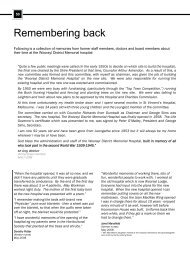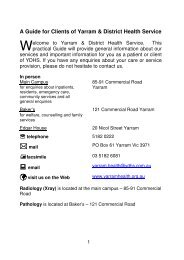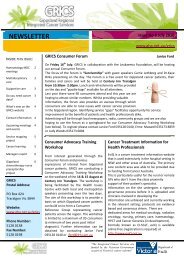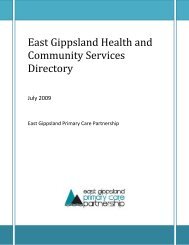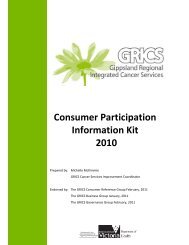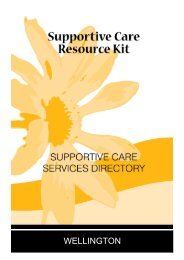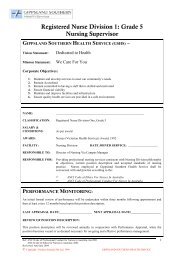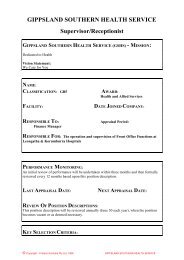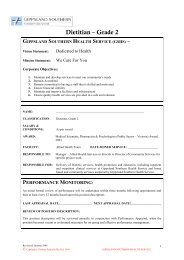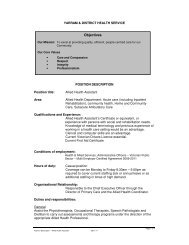safe administration of cytotoxic medications - GHA Central
safe administration of cytotoxic medications - GHA Central
safe administration of cytotoxic medications - GHA Central
Create successful ePaper yourself
Turn your PDF publications into a flip-book with our unique Google optimized e-Paper software.
SAFE ADMINISTRATION OF<br />
CYTOTOXIC MEDICATIONS<br />
GONG Cancer Care Guidelines<br />
Next Review Date: Feb 2010<br />
Responsibility: Gippsland Oncology Nurses Group<br />
Purpose: Provide comprehensive, current, evidence based guidelines regarding <strong>safe</strong><br />
<strong>administration</strong> <strong>of</strong> <strong>cytotoxic</strong> <strong>medications</strong> to inform standardized policy and<br />
procedure development across Gippsland. This guideline gives a brief<br />
overview <strong>of</strong> the principles for <strong>safe</strong> <strong>administration</strong> <strong>of</strong> chemotherapy and<br />
follows the WorkSafe Victoria guide 2003 (see references).<br />
Desired Outcome: Raise awareness <strong>of</strong> the topic <strong>of</strong> <strong>safe</strong> <strong>administration</strong> <strong>of</strong> <strong>cytotoxic</strong><br />
<strong>medications</strong> in cancer care and thereby promote best practice.<br />
Nursing staff are responsible for the <strong>safe</strong> <strong>administration</strong> <strong>of</strong> <strong>cytotoxic</strong> <strong>medications</strong> to patients as<br />
ordered by a medical <strong>of</strong>ficer. This includes checking that it is <strong>safe</strong> to administer the <strong>cytotoxic</strong><br />
<strong>medications</strong> to the patient, confirming that the <strong>cytotoxic</strong> medication labelling is correct for the<br />
patient's treatment and ensuring that the drugs are administered in line with best practice.<br />
Cytotoxic <strong>medications</strong> will be administered by Division 1 Registered nurses, in a <strong>safe</strong> manner,<br />
which complies with the WorkSafe Guidelines 2003.<br />
1. ORDERING OF<br />
CYTOTOXIC<br />
MEDICATIONS<br />
2. ENVIRONMENT<br />
Refer to GONG Guideline<br />
“Safe Handling <strong>of</strong> Cytotoxic<br />
Substances”<br />
www.gha.net.au/GRICS for<br />
further information<br />
3. NURSING<br />
COMPETENCY<br />
4. PATIENT<br />
EDUCATION<br />
A written order by a medical <strong>of</strong>ficer is required.<br />
A pharmacist must validate all <strong>cytotoxic</strong> orders and medication<br />
first, followed by two Division 1 registered nurses, checking the<br />
patient name, UR and date <strong>of</strong> birth; name <strong>of</strong> medication, dose,<br />
mode <strong>of</strong> delivery, frequency and time <strong>of</strong> <strong>administration</strong>,<br />
expiration <strong>of</strong> the drug and carrier fluid; and doctor’s signature.<br />
Areas designated for the <strong>administration</strong> <strong>of</strong> <strong>cytotoxic</strong> <strong>medications</strong><br />
are to have a hard floor surface, which can be thoroughly<br />
cleaned. Carpet must not be used in these areas.<br />
The area should be well lit, free <strong>of</strong> clutter and pedestrian traffic<br />
kept to a minimum.<br />
Safety requirements:<br />
• Suction and oxygen.<br />
• Emergency drugs and equipment.<br />
• Spill kit.<br />
• Personal protective equipment.<br />
• Cytotoxic waste bin.<br />
• Extravasation kit.<br />
Nurses administering <strong>cytotoxic</strong> <strong>medications</strong> must be registered<br />
in Division 1 <strong>of</strong> the Victorian Nurses Board and have completed<br />
or are undertaking a relevant education program deemed<br />
appropriate by the relevant unit manager <strong>of</strong> each health<br />
service. The nurses must be able to demonstrate knowledge <strong>of</strong><br />
<strong>safe</strong> handling and practices associated with the <strong>administration</strong><br />
<strong>of</strong> <strong>cytotoxic</strong> <strong>medications</strong> to the satisfaction <strong>of</strong> the relevant unit<br />
manager <strong>of</strong> each health service.<br />
Before <strong>administration</strong> <strong>of</strong> <strong>cytotoxic</strong> <strong>medications</strong>, patients are to<br />
receive appropriately designed and delivered education,<br />
including both verbal and take home information on the<br />
medication, side effects and self care actions required.<br />
SAFE ADMINISTRATION OF CHEMOTHERAPY Gippsland Oncology Nurses Group Page 1 <strong>of</strong> 5
5. PRE-<br />
ADMINISTRATION<br />
ASSESSMENT<br />
• Check the patient has given verbal or written consent for<br />
treatment.<br />
• Check that the appropriate patient education has been<br />
delivered and is understood by the patient.<br />
• Check if relevant medical history is recorded and up to date<br />
in the patient record.<br />
• Check patient’s recent blood test results including Full Blood<br />
Examination and Biochemistry.<br />
• Assess side effect pr<strong>of</strong>ile against patient’s current<br />
medication.<br />
• Record baseline vital signs.<br />
• Discuss all abnormal results with consulting physician.<br />
• Review the relevant <strong>cytotoxic</strong> medication protocol at<br />
http://www.cancerinstitute.org.au<br />
• Assess venous access.<br />
6. PRINCIPLES OF CARE OF CHEMOTHERAPY ADMINISTRATION<br />
6.1. Management <strong>of</strong><br />
peripheral venous<br />
access<br />
6.2. Management <strong>of</strong><br />
<strong>Central</strong> Venous<br />
Access Devices<br />
Manage central venous<br />
access devices according to<br />
the relevant GONG “Cancer<br />
Care Guidelines for PICCs,<br />
Ports and Hickman’s<br />
catheters.”<br />
www.gha.net.au/GRICS<br />
Ensure patency <strong>of</strong> peripheral venous access before and during<br />
<strong>administration</strong> <strong>of</strong> <strong>cytotoxic</strong> medication by checking:<br />
• Flashback or aspiration <strong>of</strong> blood.<br />
• Ability to easily infuse solutions.<br />
• Absence <strong>of</strong> erythema, swelling and pain.<br />
• Use a newly sited cannula wherever possible.<br />
• Ensure there has been no venepuncture performed at the<br />
infusion site or proximal, in the previous twelve hours.<br />
• Avoid joints or bony prominences.<br />
• Do not use the arm on the side <strong>of</strong> an axillary lymph node<br />
dissection.<br />
• Select the smallest gauge intravenous catheter that is<br />
appropriate for the volume <strong>of</strong> fluid to be administered.<br />
• Select a vein large enough to cope with the volume <strong>of</strong> fluid<br />
to be administered.<br />
• Do not give vesicants into the cubital fossa via a peripheral<br />
cannula.<br />
• Secure the cannula so that it cannot become dislodged.<br />
• Ensure that the IV site can be clearly visualised.<br />
Ensure patency <strong>of</strong> central venous access devices before and<br />
during <strong>administration</strong> <strong>of</strong> <strong>cytotoxic</strong> medication by:<br />
• Aspiration <strong>of</strong> blood.<br />
• Ability to easily infuse solutions.<br />
• Absence <strong>of</strong> erythema, swelling and pain.<br />
Continuous infusions <strong>of</strong> vesicant drugs must be administered<br />
via a central venous access device.<br />
SAFE ADMINISTRATION OF CYTOTOXIC MEDICATIONS Gippsland Oncology Nurses Group Page 2 <strong>of</strong> 5
6.3. Management during<br />
intravenous<br />
<strong>administration</strong><br />
6.4. Management <strong>of</strong><br />
vesicant <strong>medications</strong><br />
A VESICANT<br />
MEDICATION IS capable<br />
<strong>of</strong> causing pain,<br />
inflammation, blistering and<br />
ulceration <strong>of</strong> skin that leads<br />
to tissue necrosis. The final<br />
result may be dystrophy or<br />
atrophy, scar formation,<br />
damage to nerves, muscles<br />
and loss <strong>of</strong> limb function if<br />
severe<br />
Refer to Appendix 1 for<br />
identification <strong>of</strong> vesicant<br />
<strong>medications</strong><br />
6.5. Management <strong>of</strong><br />
subcutaneous/intra<br />
muscular <strong>cytotoxic</strong><br />
<strong>medications</strong><br />
6.6. Management <strong>of</strong><br />
topical <strong>cytotoxic</strong><br />
<strong>medications</strong><br />
6.7. Management <strong>of</strong> oral<br />
<strong>cytotoxic</strong><br />
<strong>medications</strong><br />
• Intravenous equipment must include syringes and lines with<br />
luer lock connections, lines with one-way or non-return<br />
valves and add-a-lines. Needle-less <strong>administration</strong> systems<br />
must be used.<br />
• Back-priming technique is to be used, with intravenous adda-lines,<br />
before and after <strong>administration</strong> <strong>of</strong> <strong>cytotoxic</strong><br />
<strong>medications</strong>.<br />
• A multiple access connection (eg. 3-way tap) should be<br />
used on chemotherapy lines in case <strong>of</strong> hypersensitivity<br />
reaction.<br />
• Cytotoxic <strong>medications</strong> must be handled at waist level.<br />
• Monitor patient closely during <strong>cytotoxic</strong> medication<br />
<strong>administration</strong> according to relevant protocol.<br />
• Following completion <strong>of</strong> <strong>administration</strong> <strong>of</strong> <strong>cytotoxic</strong><br />
<strong>medications</strong> equipment must be disposed <strong>of</strong>, intact, into the<br />
<strong>cytotoxic</strong> waste bin.<br />
• Always wash hands after completion <strong>of</strong> <strong>administration</strong> <strong>of</strong><br />
<strong>cytotoxic</strong> medication.<br />
Administration <strong>of</strong> vesicant <strong>medications</strong> must be according to the<br />
following principles:<br />
• Vesicant <strong>medications</strong> must be administered before nonvesicant<br />
<strong>medications</strong>.<br />
• Continuous infusions <strong>of</strong> vesicant <strong>medications</strong> must be<br />
administered via a central venous access device.<br />
• Short, peripheral infusions <strong>of</strong> vesicant <strong>medications</strong> must be<br />
via a fast flowing intravenous line, not through infusion<br />
pumps.<br />
• Chemotherapy nurse must remain with the patient at all<br />
times during <strong>administration</strong> <strong>of</strong> vesicant <strong>medications</strong> for<br />
rapid assessment <strong>of</strong> extravasation.<br />
General principles <strong>of</strong> <strong>safe</strong> handling and <strong>administration</strong> <strong>of</strong><br />
<strong>cytotoxic</strong> <strong>medications</strong> needs to be followed including wearing<br />
Personal Protective Equipment and disposal <strong>of</strong> waste (syringes)<br />
into a <strong>cytotoxic</strong> bin.<br />
General principles <strong>of</strong> <strong>safe</strong> handling and <strong>administration</strong> <strong>of</strong><br />
<strong>cytotoxic</strong> <strong>medications</strong> needs to be followed including wearing<br />
Personal Protective Equipment (Gloves) and use <strong>of</strong> a disposable<br />
spatula for application <strong>of</strong> <strong>cytotoxic</strong> topical agents and disposal<br />
<strong>of</strong> waste (spatula and gloves) into a <strong>cytotoxic</strong> bin.<br />
• Do not crush or break <strong>cytotoxic</strong> tablets/capsules for any<br />
reason.<br />
• Instruct patient to swallow tablet/capsule whole.<br />
• All <strong>medications</strong> will be provided from pharmacy in<br />
appropriately labelled “caution-<strong>cytotoxic</strong>s” containers with<br />
instructions.<br />
SAFE ADMINISTRATION OF CYTOTOXIC MEDICATIONS Gippsland Oncology Nurses Group Page 3 <strong>of</strong> 5
6.8. Documentation • Ensure all appropriate documentation is recorded in the<br />
patient’s medical record.<br />
• Ensure all drug orders are signed by two registered nurses<br />
administering and checking the <strong>cytotoxic</strong> <strong>medications</strong>.<br />
• Documentation should be done in real time, not at the end<br />
<strong>of</strong> the shift.<br />
REFERENCES<br />
1. American Society <strong>of</strong> Health-System Pharmacists. (2002). ASHP guidelines on preventing medication<br />
errors with antineoplastic <strong>medications</strong>. Am J Health-Syst Pharm. 59:1648-68.<br />
2. Bayside Health. (2005). Guidelines for <strong>safe</strong> handling <strong>of</strong> <strong>cytotoxic</strong> drugs. Bayside Health.<br />
3. British Columbia Cancer Agency. (2006). Policy: Chemotherapy process. British Columbia Cancer<br />
Agency.<br />
4. Cancer Institute NSW. (2005). Management <strong>of</strong> <strong>cytotoxic</strong> drugs and waste.<br />
http://www.cancerinstitute.org.au/<br />
5. Cancer Nurses Society <strong>of</strong> Australia. (2003). Chemotherapy Position Statement on the minimum<br />
education and <strong>safe</strong>ty requirements for nurses involved in the <strong>administration</strong> <strong>of</strong> <strong>cytotoxic</strong> drugs. CNSA.<br />
6. Labuhn, K., Valanis, B., Schoey, R., Loveday, K. & Vollmer, W.M. (1998). Nurses’ and pharmacists’<br />
exposure to antineoplastic drugs: findings from industrial hygiene scans and urine mutagenicity tests.<br />
Cancer Nursing. 21(2): 79-89.<br />
7. Latrobe Regional Hospital. (2005). Cytotoxic substances-Administration <strong>of</strong> <strong>cytotoxic</strong> drugs protocol.<br />
Latrobe Regional Hospital.<br />
8. Latrobe Regional Hospital. (2006). Cytotoxic substances-Administration <strong>of</strong> <strong>cytotoxic</strong> drugs policy.<br />
Latrobe Regional Hospital.<br />
9. Latrobe Regional Hospital. (2006). Cytotoxic substances-<strong>safe</strong> handling policy. Latrobe Regional<br />
Hospital.<br />
10. Peter MacCallum Cancer Centre. (2004). Disposal <strong>of</strong> <strong>cytotoxic</strong> waste. Policy and procedure. Peter<br />
MacCallum Cancer Centre.<br />
11. Peter MacCallum Cancer Centre. (2005). Administration and management <strong>of</strong> <strong>cytotoxic</strong> drugs. Policy<br />
and procedure. Peter MacCallum Cancer Centre.<br />
12. SHPA Committee <strong>of</strong> Specialty Practice in Oncology. (2005). SHPA Standards <strong>of</strong> practice for the <strong>safe</strong><br />
handling <strong>of</strong> <strong>cytotoxic</strong> drugs in pharmacy departments. Journal <strong>of</strong> Pharmacy Practice and Research.<br />
Vol 35 (1): 44-52.<br />
13. WorkSafe Victoria. (2003). Handling <strong>cytotoxic</strong> drugs in the workplace. WorkSafe Victoria.<br />
SAFE ADMINISTRATION OF CYTOTOXIC MEDICATIONS Gippsland Oncology Nurses Group Page 4 <strong>of</strong> 5
APPENDIX 1<br />
CLASSIFICATION OF CYTOTOXIC AGENTS BY<br />
EXTRAVASATION POTENTIAL<br />
Cancer Institute NSW. (2005). Classification <strong>of</strong> <strong>cytotoxic</strong> agents by extravasation potential<br />
http://www.cancerinstitute.org.au/<br />
1. Vesicants:<br />
Capable <strong>of</strong> causing pain, inflammation, blistering and ulceration <strong>of</strong> skin that leads to tissue necrosis. The<br />
final result may be dystrophy or atrophy, scar formation, damage to nerves, muscles and loss <strong>of</strong> limb<br />
function if severe.<br />
1.1 Amsacrine<br />
1.2 Cisplatin>0.4mg/ml<br />
1.3 Dactinomycin<br />
1.4 Daunorubicin<br />
1.5 Doxorubicin<br />
1.6 Epirubicin<br />
1.7 Idarubicin<br />
1.8 Mitomycin C<br />
1.9 Mitoxantrone<br />
1.10 Mustine<br />
1.11 Vincristine<br />
1.12 Vinblastine<br />
1.13 Vindesine<br />
1.14 Vinorelbine<br />
1.15 Paclitaxel<br />
2. Irritants:<br />
Capable <strong>of</strong> causing tissue inflammation, irritation and pain extending to phlebitis but without leading to<br />
tissue damage or necrosis.<br />
2.1 Busulphan<br />
2.2 Docetaxel<br />
2.3 Cisplatin<br />
2.4 Etoposide<br />
2.5 Carmustine<br />
2.6 Fotemustine<br />
2.7 Dacarbazine<br />
2.8 Gemcitabine<br />
2.9 Liposomal Doxorubicin<br />
2.10 Melphalan<br />
2.11 Liposomal Daunorubicin<br />
2.12 Oxaliplatin<br />
2.13 Streptozocin<br />
2.14 Treosulfan<br />
2.15 Teniposide<br />
2.16 Trimetrexate<br />
3. Non Irritants (Neutrals):<br />
3.1 Asparaginase<br />
3.2 Etoposide phosphate<br />
3.3 Bleomycin<br />
3.4 Fludarabine<br />
3.5 Carboplatin<br />
3.6 Fluorouracil<br />
3.7 Cladribine<br />
3.8 Ifosfamide<br />
3.9 Cyclophosphamide<br />
3.10 Irinotecan<br />
3.11 Cytarabine<br />
3.12 Methotrexate<br />
3.13 Estramustine<br />
3.14 Pegaspargase<br />
3.15 Pentostatin<br />
3.16 Thiotepa<br />
3.17 Raltitrexed<br />
3.18 Topotecan<br />
SAFE ADMINISTRATION OF CYTOTOXIC MEDICATIONS Gippsland Oncology Nurses Group Page 5 <strong>of</strong> 5




